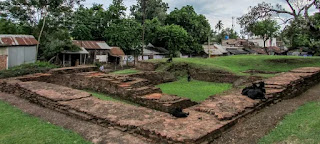Chandraketugarh is an archaeological site located beside the Bidyadhari river, about 35 kilometres (22 mi) north-east of Kolkata, India, in the district of North 24 parganas, near the township of Berachampa and the Harua Road railhead.
Excavation between 1957-68 (conducted by Asutosh Museum of Indian Art) revealed relics of several historical periods, although the chronological classification of the relics remains incomplete.
According to some historians, the Chandraketugarh site and surrounding area could be the place known to ancient Greek and Roman writers as having the same name as the river Ganges (Γάγγης) sometimes referred to as ‘Gangaridai’.
Chandraketu’s Fort is included in the List of Monuments of National Importance in West Bengal by the Archaeological Survey of India (serial no. N-WB-1).
Chandraketugarh is thought to be a part of the ancient kingdom Gangaridai that was first described by Ptolemy. The history of Chandraketugarh dates back to almost the 3rd century BC, during the pre-Mauryan era. Artefacts suggest that the site was continuously inhabited and flourished through the Shunga-Kushana period, onwards through the Gupta period and finally into the Pala-Sena period. Archaeological studies suggest that Chandraketugarh was an important town and a port city. It had a high encircling wall complete with a rampart and moat. The residents were involved in various crafts and mercantile activities. Although the religious inclinations of the people are unclear, hints of the beginning of some future cults can be seen in the artefacts. Some of the potteries carry inscriptions in Kharoshthi and Brahmi scripts.
Brahmi inscriptions with Megalithic Graffiti Symbols read “yojanani setuvandhat arddhasatah dvipa tamraparni”, meaning “The island of Tamraparni (ancient Sri Lanka) is at a distance of 50 yojanas from Setuvandha (Rameswaram in Tamil Nadu). The mast of a ship with Vijayasinha’s seal, describing Vijayasinha, the son of the king of Sinhapura of Vanga’s marriage to Kuveni – the indigenous “Yakkha queen of Tamraparni”. Chandraketugarh features many examples of terracotta art, displaying an unusual degree of precision and craftsmanship. These plaques are comparable to those found at other better-known sites such as Kaushambi and Ahichhatra. The terracotta plaques from these sites often carry similar motifs executed in nearly identical fashion. This similarity suggests an established communication link and common cultural heritage among these sites.
Finds include Northern Black Polished Ware (NBPW) relics, later wares dated from about 400 BC to 100 BC and approximately contemporary with the Maurya period, as well as from the more recent Kushanas and Gupta periods.
Many silver punch-marked coins and a few gold coins have been unearthed from Chandraketugarh, including a gold coin of Chandragupta-Kumardevi. Many semi-precious stone beads were also found here, along with items made of ivory and bone. Even a few wooden objects have survived.
(From Wikipedia)
